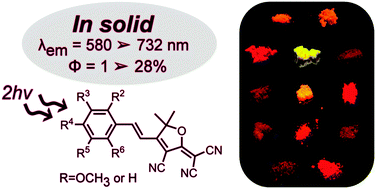Solid state red biphotonic excited emission from small dipolar fluorophores†
Abstract
Dyes emitting in the solid state in the red or near-infrared range are much sought after for application in bioimaging especially if the long emission wavelength can be combined with two-photon excitation to provide unique contrast and penetration depth. In this article we present a series of small push–pull dipolar fluorophores based on 2-dicyanomethylene-3-cyano-4,5,5-trimethyl-2,5-dihydrofurane as electron accepting group. Compounds 1a–1m differ only by the number (one, two or three) and the position of methoxy groups on the electron-donor part. If these compounds are weakly emissive in dilute solution, they exhibit aggregation-induced emission properties and exciting solid state emission in the red – near infrared range very different from one compound to another highlighting the role of the number and of the position of the methoxy electron-donor groups. The solid-state properties were studied by fluorescence spectroscopy and the solid state structures were analyzed by X-ray diffraction showing the presence of a long chain of specific aggregates for the emitting species. Finally, the two-photon excitation properties were measured over the range 780–920 nm directly on the solid.


 Please wait while we load your content...
Please wait while we load your content...